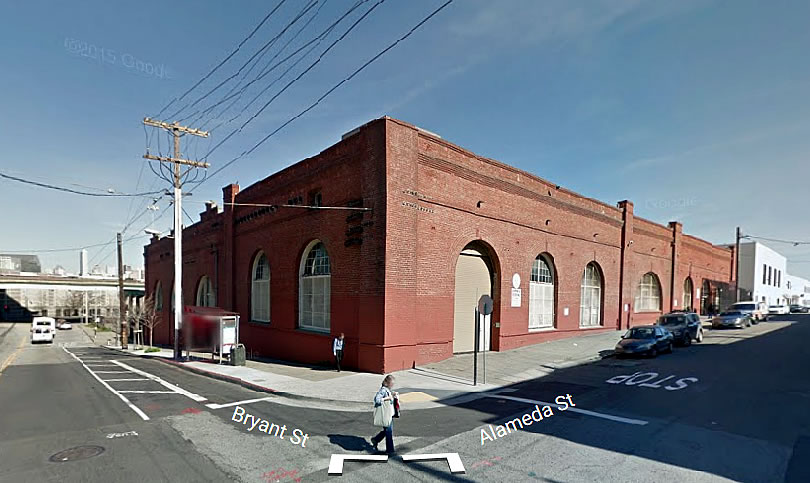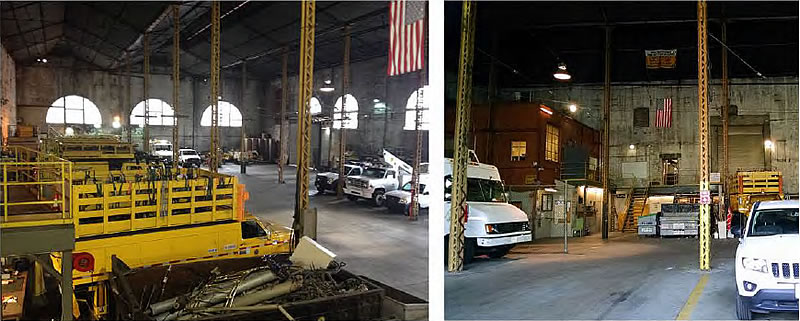The San Francisco Municipal Transit Agency is planning to vacate the historic Municipal Railway Overhead Lines building at 1401/1419 Bryant Street which was built in 1893.
And as proposed, the interior of the building will be gutted and an all-new building will be constructed within the envelope of the exterior brick walls, with a new second floor and 5,000 square feet of open air dog runs for the proposed new tenant: San Francisco Animal Care and Control.
The new Animal Care and Control facility would replace ACC’s existing facility at 1200 15th Street, providing improved education/training facilities for the public, volunteers and staff, and improving seismic performance to assure the ACC can provide first responder and ongoing services following a major earthquake.
The projected budget for the project is roughly $26.5 million and the preliminary plans have been delivered to San Francisco’s Planning Department to review.


AARF!!!!
What about the huge parking lot next door? Who controls that?
Duuuude,
If you rip out the entire interior of a building and only leave the skin, then it wasn’t really that historic to begin with, now was it? There can’t possibly be anything “historic” about brick when its completely stripped of it’s original context.
Building materials, construction techniques, and project types all work together. Once you start removing them from one another, the building loses any historical context it once had. Is the saved brick facade going to somehow be indicative of the building type of today, construction methods, or program use of the sites new occupant? If the answer is no, then there really is no strong argument for maintaining this historical element, now is there?
This city has a bizarre (i.e., stupid) fascination with holding onto a “historic” architectural vernacular that never really existed. It unnecessarily shackles contemporary design and even worse, prevents the city from establishing a new architectural identity unique to today.
Woof.
That’s my favorite building in the area.
The building interior has no value, it’s a garage, the only historic value is the facade as it fits into the context of the historic city it’s a part of and more specifically the other historic brick warehouses in that area that have also been preserved and reused. Adaptive reuse is a common building practice around the world to adapt aethetically pleasing and historic structures to modern day uses and building technologies. They have been doing this for centuries in Europe and it’s common practice in other US cities with historic value.
Yes! Even in pictures of its original use as a Market Street Railway powerhouse, it looks like has always been a big shelter for heavy equipment without much in terms of structure or distinctiveness on the inside.
The exterior has lots of interesting context in itself, including its rows of holes for communication wires.
There’s some value to the interior. Those iron bar lattice posts are uncommon on the west coast. If they’re removed in the remodel then hopefully they’re re-used instead of melted down for scrap.
Oh, well then, why stop there? Why not return to dirt roads? Horse and buggy? Oh, right! We don’t live like that anymore!
The fascination of preserving a building skin while purposefully gutting the entire interior, program, and building use is a perverse interpretation of historic preservation. You said yourself, historic “BRICK WAREHOUSE” It’s no longer a warehouse. Now its just brick. That’s it. You’re fighting to preserve brick for a district that is changing uses. And for what purpose? To acknowledge that the neighborhood was once something different? I’m wildly unmoved by that argument. If you’re so easily willing to deny the buildings interior value, then it’s really hard for me to be sympathetic to your position when you turn around and go to war for the exterior facade for seemingly no compelling reason. And I’m especially unmoved when you consider that contextually, the building is next to a Best Buy and a 24 Hour Fitness/Safeway Combo.
To be blunt, the organic materials and the details are more humanly scaled and interesting than concrete panels or manufactured metal panels would be.
I have no problem with preserving this skin. It’s a cool skin. Not EVERYTHING has to be a bland condo tower. And I am usually very pro-development.
Having adopted from AC & C, I would love for them to have a nicer facility…
so many people go to SPCA because it is a more pleasant experience. AC & C has a very large array of animals, from the expected dogs and cats to bunnies and birds that need dedicated spaces: hope this goes thru!
Wait! There are two facilities for animals? Why not merge the two and save some coin?
If I see a dead skunk on the side of the street, don’t I call Animal Control to dispose of it?
ACC is the city. Yes, they’ll (eventually) take care of dead skunks.
SFSPCA is a private non profit rescue organization.
I support the AC&C with my tax dollars and the SPCA with my voluntary,m tax deductible, contributions. You should too. The SPCA offers many services the government, in the form of the AC&C never should or could such as a state of the art, reasonable cost specialty animal hospital. It will take people’s unwanted animals and adopt them out–it is a “no kill” shelter–so that they never go to the AC&C but for those animals that are simply abandoned or a nuisance or dangerous or otherwise in need of “care and control”, the AC&C is the agency of last resort. And since those animals deserve humane treatment as well and some of them can still make fine pets, I’m very glad for the AC&C to get a better space.
$26.5 million for animals? Or surrogate children for some? First responders for animals after a major earthquake? Move aside people, we need to administer CPR to the dog.
Some pet owners will refuse to evacuate if it means leaving pets behind.
In less advanced cities and towns, lack of facilities for peoples pets causes all sorts of problems after a disaster starting with the fact that, as said, many humans will not participate in evacuations or shelter housing or whatever if their pets are not cared for. In fact, the Bay Area has been called on to adopt abandoned pets after disasters around the country because there were no local facilities for doing so. Whether or not you accept animals as “surrogate children”, they are part of the human ecosystem and a part that deserves both humane treatment and appropriate planning for their care. Humans may be at the top of the food chain, but that just gives us responsibilities as well as privileges.
This is a first world problem then. Because I met Nepalese women with families in the earthquake-damaged region who were much more concerned with their human families and other people. If you care more about your pet than people, you are in the small minority in the bigger scheme of things,
We are all small minorities in the bigger scheme of things. Obsessing about other people’s love of pets is pretty “small” minded in itself , no? Or are you a homeless waif who has donated all of your income to the poor?
My taxes pay for various programs related to children whether I like it or not—and certainly to a tune much higher than $26 million. Pets are a much more reasonable alternative to children for a lot of urban dwellers.
You were a child once, correct? And benefited from someone else’s taxes subsidizing you. When you grow old and are on Medicare, who is subsidizing you? The children of today.
Not my preferred re-use of the space, but… I guess its better than vacant. Would be a great spot for a music/event venue… with a small cafe for a little street activation.
For hipster self-indulgence. Just what we need more of.
I’m totally with you along that thinking!
What exactly constitutes a hipster these days? Serious question. Thanks
I know, my question exactly. Does it mean millenials working in the tech industry? Male and female? High income only? When I hear hipsters, I think of a kind of underwear or folks who had a hip replacement.
skinny jeans, tatoos and fixies
i prefer dogs over hipsters any day of the week
Yep. No contest!
How do hipsters have anything to do with a music venue or cafe?
So much for a multidisciplinary arts space. This part of town has gone from a burgeoning arts scene to a canine facility wasteland. That’s a shame.
It’s currently a bus parking garage. How does this project accomplish your complaint?
What fantastic news! Please let this actually happen for ACC.The current facility is cold for the animals, decrepit and not at all functional for its needs.
Big fan of that building. Always notice it while on the freeway and anywhere near it on street level. If cleaned up, it could look like the historic portion of the Contemporary Jewish Museum in SOMA.
If you have ever adopted a pet in SF you have probably walked back and forth at least once between SF SPCA and SF ACC, looking at the critters at both, which are currently separated by about one block. This will add another block or so to the walk, but that may allow you to make up your mind faster.
We are currently 5 years into generation 3 of our SF kitties, from Carter to Obama.
This is good news! I like this building too, so I did some research on it a few months ago and all I could find about its future was that the cost of renovating the building for seismic safety would be massive. I’m happy that people are working on figuring out how to adapt it instead of just knocking it down.
Very cool.
Who’s that guy pontificating about how a city must feel about its architectural self-reference, aesthetic, progression, and conceptualization? Nothing is “written”, and if per chance it is, then it can be erased…or not…either physically or in terms of ideas. Perhaps San Francisco has a schizoid approach, and that OK, too.